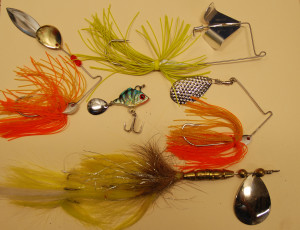By Chris Erwin
Editors Note: This is the third of a five-part series “Learning the Four Bait Categories.” We hope to help anyone trying to learn how to become a better bass fisherman. If you have questions, send them to Trimmer308@windstream.net
One of the reasons why spinnerbaits are treated as a bait category is because of just how much of the water table you can cover with these types of baits. However, before we get into that we need to list some of the common configurations these baits come in. Buzzbaits, inline spinners, and safety-pin spinners are all common types and with them you can cover the water from the top to the bottom.
As you learn more about bass fishing you will meet anglers who specialize in different bait categories. This happens because people build confidence in what works for them. The more confidence you build in a bait the more you want to go to that bait. Since spinnerbait can be fished in almost any situation and at any depth, it stands to reason some anglers are going to stick with what they think will work.

While we have listed the basic three spinnerbaits it doesn’t take too much research to see there are a lot of subcategories you should become familiar with too. Single-spin, double-spin, short-arm drop spinners, long-arm thumpers, “R” eyes or twisted eyes, all of these configurations are used in different environmental conditions. Then there is color and the rainbow can literally be in your box.
We could write a complete book on each of these categories, there is so much to know but our goal here is to give a point of reference, so you can build your own confidence in what works and when.
If you are just learning, I would suggest starting with small baits, measuring a quarter ounce or so. I’m a firm believer that big baits catch big fish but little baits can catch any size fish depending on presentation and the body on water you’re on. For the sake of building confidence, small baits usually draw more strikes and you should get a good feel of how to produce a strike. Your line weight should match your bait size, in other words, don’t throw a quarter ounce bait on 25-pound line. Stick to 10 to 14-pound test line and a fast tip rod.
Watch your bait as it is coming in and learn speed control. You need to visualize the bait under the water, see it coming through the water in your mind. Safety-pin type baits are pretty weedless and can be fished in down trees, weeds and other structure where slowly dragging the bait over thick cover can be very productive. Your focus and creative ability will pay off if you build on what you learn each time out.
Try to match success with the conditions that produced that success. Know this! Catching fish is not luck! I can’t stress that enough. In all the tournaments I fished, I always knew who was going to be the guys to beat because the same people always showed up with fish.
I’m not a big color freak. I use the rule dark baits on dark days and light baits on bright days. Why? Because when a fish hits bait he’s made a mistake, period! They tend to make more mistakes when they don’t get a good look at the bait. I want them to see the flash or feel the vibration. Water color can also influence lure color, the dirtier the water the brighter the bait.
I wish I had the space to cover every aspect of each bait category but I’m here and I will try to answer any of your questions you may be wondering about. Get out there, get some spinnerbaits and learn how to use them!



Be the first to comment